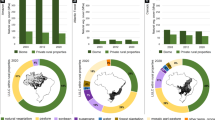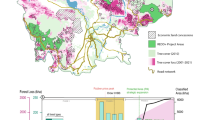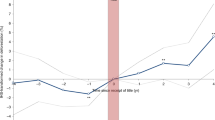Abstract
The Brazilian Amazon rainforest is protected largely by command and control regulation of public and private land. The Brazilian Forest Act requires private landholders within the Amazon to set aside 80% of their land as legal reserves for nature protection, but this requirement can be reduced to 50% if more than 65% of a state’s territory is protected public land (for example, public conservation units and indigenous reserves). In the ongoing land designation process in Brazil, some Amazonian states may cross this 65% threshold. We assess the potential reduction in the legal reserve requirement from 80% to 50%, through spatially explicit modelling of scenarios concerning land tenure consolidation, employing up-to-date databases on land ownership. Depending on the outcome of land designation processes and political priorities, some 6.5–15.4 million hectares of private land previously protected as legal reserves may become available for legal deforestation. While protection of public land is crucial for safeguarding the Amazon, revisions of federal and state legislation may be needed to avoid the further extension of protected public land triggering increased legal deforestation on private lands. Zero-deforestation commitments and other initiatives may mitigate impacts in the absence of such revision.
This is a preview of subscription content, access via your institution
Access options
Access Nature and 54 other Nature Portfolio journals
Get Nature+, our best-value online-access subscription
$29.99 / 30 days
cancel any time
Subscribe to this journal
Receive 12 digital issues and online access to articles
$119.00 per year
only $9.92 per issue
Buy this article
- Purchase on Springer Link
- Instant access to full article PDF
Prices may be subject to local taxes which are calculated during checkout



Similar content being viewed by others
Data availability
All input datasets used to conduct our analysis are publically available from the cited references. Raw data associated with figures in this manuscript as well as intermediate files are available from the corresponding author upon request.
References
Soares-Filho, B. et al. Cracking Brazil’s Forest Code. Science 344, 363–364 (2014).
Azevedo, A. A. et al. Limits of Brazil’s Forest Code as a means to end illegal deforestation. Proc. Natl Acad. Sci. USA 114, 7653–7658 (2017).
Freitas, F. L. M. et al. Who owns the Brazilian carbon? Glob. Chang. Biol. 24, 2129–2142 (2018).
Barber, C. P., Cochrane, M. A., Souza, C. M. Jr & Laurance, W. F. Roads, deforestation, and the mitigating effect of protected areas in the Amazon. Biol. Conserv. 177, 203–209 (2014).
Lapola, D. M. et al. Pervasive transition of the Brazilian land-use system. Nat. Clim. Change 4, 27–35 (2014).
Ferreira, J. et al. Brazil’s environmental leadership at risk. Science 346, 706–707 (2014).
Asner, G. P. et al. Selective logging in the Brazilian Amazon. Science 310, 480–482 (2005).
Richards, P. D., Walker, R. T. & Arima, E. Y. Spatially complex land change: the indirect effect of Brazil’s agricultural sector on land use in Amazonia. Glob. Environ. Change 29, 1–9 (2014).
Brazilian Native Vegetation Protection Law No 12.651 (Presidência da República do Brasil, 2012).
Sparovek, G., Berndes, G., Barretto, A. G. d. O. P. & Klug, I. L. F. The revision of the Brazilian Forest Act: increased deforestation or a historic step towards balancing agricultural development and nature conservation?. Environ. Sci. Policy 16, 65–72 (2012).
Pack, S. M. et al. Protected area downgrading, downsizing, and degazettement (PADDD) in the Amazon. Biol. Conserv. 197, 32–39 (2016).
Azevedo-Ramos, C. & Moutinho, P. No man’s land in the Brazilian Amazon: could undesignated public forests slow Amazon deforestation? Land Use Policy 73, 125–127 (2018).
Sparovek, G., Barretto, A. G. d. O. P., Matsumoto, M. & Berndes, G. Effects of governance on availability of land for agriculture and conservation in Brazil. Environ. Sci. Technol. 49, 10285–10293 (2015).
Damasceno, R., Chiavar, J. & Lopes, C. L. Evolution of Land Rights in Brazil (PUC-Rio, Climate Policy Initiative, 2017); https://climatepolicyinitiative.org/wp-content/uploads/2017/06/Evolution_of_Land_Rights_In_Rural_Brazil_CPI_FinalEN.pdf.
STF. in Ação Direta De Inconstitucionalidade (Medida Liminar) – 4901 (ed Court, BS) (Brasilia, 2018); http://portal.stf.jus.br/processos/detalhe.asp?incidente=4355097.
Act for Tenure Regularization of Rural and Urban Land Law No 13.465 (Presidência da República do Brasil, 2017).
Soares-Filho, B. et al. Role of Brazilian Amazon protected areas in climate change mitigation. Proc. Natl Acad. Sci. USA 107, 10821–10826 (2010).
Walker, W. et al. Forest carbon in Amazonia: the unrecognized contribution of indigenous territories and protected natural areas. Carbon Management 5, 479–485 (2014).
Pfaff, A., Robalino, J., Lima, E., Sandoval, C. & Herrera, L. D. Governance, location and avoided deforestation from protected areas: greater restrictions can have lower impact, due to differences in location. World Dev. 55, 7–20 (2014).
Barlow, J. et al. Anthropogenic disturbance in tropical forests can double biodiversity loss from deforestation. Nature 535, 144–147 (2016).
Nepstad, D. et al. Slowing Amazon deforestation through public policy and interventions in beef and soy supply chains. Science 344, 1118–1123 (2014).
Sparovek, G. et al. Asymmetries of cattle and crop productivity and efficiency during Brazil’s agricultural expansion from 1975 to 2006. Elem. Sci. Anth. 6, 25 (2018).
Cerri, C. E. P. et al. Reducing Amazon deforestation through agricultural intensification in the cerrado for advancing food security and mitigating climate change. Sustainability 10, 989 (2018).
Strassburg, B. B. N. et al. When enough should be enough: Improving the use of current agricultural lands could meet production demands and spare natural habitats in Brazil. Glob. Environ. Change 28, 84–97 (2014).
Phalan, B. et al. How can higher-yield farming help to spare nature? Science 351, 450–451 (2016).
Nobre, C. A. et al. Land-use and climate change risks in the Amazon and the need of a novel sustainable development paradigm. Proc. Natl Acad. Sci. USA 113, 10759–10768 (2016).
Tritsch, I. & Arvor, D. Transition in environmental governance in the Brazilian Amazon: emergence of a new pattern of socio-economic development and deforestation. Land Use Policy 59(Suppl. C), 446–455 (2016).
Garrett, R. D. et al. Explaining the persistence of low income and environmentally degrading land uses in the Brazilian Amazon. Ecol. Soc. 22, 27 (2017).
Carvalho, G., Cristina Barros, A., Moutinho, P. & Nepstad, D. Sensitive development could protect Amazonia instead of destroying it. Nature 409, 131 (2001).
Guidotti, V. Números Detalhados do Novo Código Florestal e Suas Implicações para os PRAs Principais Resultados e Considerações (IMAFLORA, Piracicaba, 2017). .
d Freitas, F. L. M. d. et al. Offsetting legal deficits of native vegetation among Brazilian landholders: Effects on nature protection and socioeconomic development. Land Use Policy 68, 189–199 (2017).
Reydon, B. P., Fernandes, V. B. & Telles, T. S. Land tenure in Brazil: the question of regulation and governance. Land Use Policy 42, 509–516 (2015).
SFB National System for Rural Environmental Registry (Brazilian Forest Service, 2015).
Freitas, F. L. M., Guidotti, V. & Sparovek, G. Atlas – A Geografia da Agropecuária Brasileira 2017 Technical Note: Land Tenure Map of Brazil, v.170321 (Instituto de Manejo e Certificação Florestal e Agrícola – Imaflora, 2017).
Hengl, T. et al. SoilGrids250m: Global gridded soil information based on machine learning. PLoS One 12, e0169748 (2017).
Farr, T. G. et al. The Shuttle Radar Topography Mission. Rev. Geophys. 45, RG2004 (2007).
WorldClim Free Climate Data for Ecological Modeling and GIS (Global Climate Data, 2017).
ArcGIS Version 10.3.1 (Environmental Systems Research Institute Inc, 2010).
Englund, O., Berndes, G., Persson, M. & Sparovek, G. Oil palm for biodiesel in Brazil—risks and opportunities. Environ. Res. Lett. 10, 044002 (2015).
Land Tenure Database (National Institute of Colonization and Agrarian Reform, 2015).
IBGE Vegetation Map (Brazilian Institute of Geography and Statistics, 1993).
Englund, O. et al. A new high-resolution nationwide aboveground carbon map for Brazil. Geo Geography Environ. 4, e00045 (2017).
MMA Priority Areas for Biodiversity Conservation and Sharing of Brazilian Biodiversity: 1st Update Ordinance MMA no. 9 (Ministry of Environment DoBaF, 2007).
Acknowledgements
We would like to express our appreciation to L. Fernando Guedes Pinto and V. Guidotti, who revised this manuscript, providing comments and suggestions that helped us improve the article. We are also grateful to the Brazilian National Council for Scientific and Technological Development (CNPQ, grant no. 249404/2013-3) and the São Paulo Research Foundation (FAPESP, grant no. 2016/17680-2) for financing this research.
Author information
Authors and Affiliations
Contributions
F.L.M.F., G.S., G.B., M.P. and U.M. conceived and designed the study. F.L.M.F. carried out data processing, data analysis and prepared the first draft of the manuscript. O.E. and A.B. provided support in the elaboration of the indicators of market access and land suitability. All authors contributed to results interpretation and paper writing.
Corresponding author
Ethics declarations
Competing interests
The authors declare no competing interests.
Additional information
Publisher’s note: Springer Nature remains neutral with regard to jurisdictional claims in published maps and institutional affiliations.
Supplementary information
Supplementary Information
Supplementary Tables 1–3, Supplementary Figures 1–2, Supplementary References 1–9
Rights and permissions
About this article
Cite this article
Freitas, F.L.M., Sparovek, G., Berndes, G. et al. Potential increase of legal deforestation in Brazilian Amazon after Forest Act revision. Nat Sustain 1, 665–670 (2018). https://doi.org/10.1038/s41893-018-0171-4
Received:
Accepted:
Published:
Issue Date:
DOI: https://doi.org/10.1038/s41893-018-0171-4
This article is cited by
-
Agricultural trade impacts global phosphorus use and partial productivity
Nature Food (2023)
-
Slow-down of deforestation following a Brazilian forest policy was less effective on private lands than in all conservation areas
Communications Earth & Environment (2023)
-
Impacts of a large-scale titling initiative on deforestation in the Brazilian Amazon
Nature Sustainability (2020)
-
Improved estimates of forest cover and loss in the Brazilian Amazon in 2000–2017
Nature Sustainability (2019)



